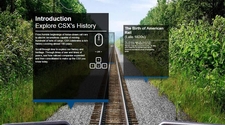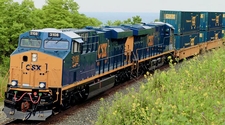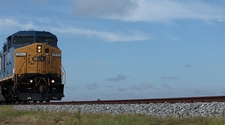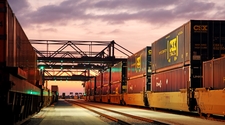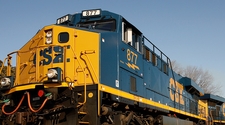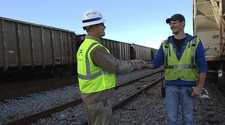| O-S ing |
Reporting a train by station to the train dispatcher. |
| OBT (On Board Terminal) |
A laptop computer mounted in the operating cab of a locomotive, used to report work performed (cars picked up/pulled at customers/on line of road) to the CSC. |
| Occupied Caboose |
A rail car being used to transport non-passenger personnel. |
| Ocean Carrier |
A common transportation carrier whose service is dedicated to ocean traffic. The ocean carrier is regulated by the Federal Maritime Commission and engaged in foreign commerce as defined in the Shipping Act of 1916. |
| Office Car |
Car used by railway officials for business purposes. |
| Official Railway Guide |
A semi-monthly publication which lists all railroads in North America alphabetically. Also contains maps of various railroads, timetables, corporate officers, sales representatives, etc. |
| Ohm |
The unit of electrical resistance. |
| Ohm Meter |
An instrument for measuring resistance in ohms. |
| Ohms Law |
The fundamental law of flow of electricity in a circuit. The rate of flow in amperes is equal to the electric pressure in volts divided by the resistance in ohms. |
| On Line |
The ability to view or update data instantaneously via a computer terminal. |
| On the Foul (Slang) (AKA Out of Clear) |
Blocking other tracks with cars, engines or equipment. |
| On the Ground |
Derailed equipment. |
| On the Point |
To ride on the leading end of a car or engine to protect the movement. |
| One-Time Refund |
A reduction in revenue because an incentive was given to encourage shipping. |
| OPA (Opportunity Pricing Action) |
Short term contracts on "Exempt" carload traffic. |
| Open and Prepay |
Publication which lists all the stations in the US, Mexico and Canada to which rail shipments can be made. It also indicates the railroad that switches each station and any limitations applying to service (i.e. Team Track only or height restrictions). |
| Open Item |
An account or freight bill number for which the balance due has not been brought to zero. |
| Open Route |
When the route does not contain all of the route, junction points, or switching lines necessary to complete handling and delivery of the shipment. |
| Open Track |
A track on which cars are not standing and which is free of any obstruction. |
| Open-Top Car |
Cars having sides and ends but no roof. A term inclusive of gondola, hopper and ballast cars but does not include flat cars. |
| Operating Ratio |
The percentage of revenues that goes into operating the railroad. It is calculated by dividing railway-operating expenses by railway operating revenues. |
| Operating Rules Manual |
A publication that contains the following books: CSX Safeway Transportation, Operating Rules, Timetables, Hazardous Material Rules, Restricted Equipment Rules, Train Handling Rules, and On-Track Worker Safety Rules. |
| Opposing Signal |
Roadway signals which govern movements in opposite directions on the same track. |
| OR |
Rungs between vertical supports attached to the side and end of a freight car. |
| Order (Demurrage) |
When an industry orders specific cars for loading. |
| Order Bill of Lading |
A negotiable document. Surrender of the properly endorsed original is required upon delivery of property. |
| Order Board |
A fixed signal to indicate to approaching trains whether to pick up train orders or not. |
| Order Notify |
Service performed by the railroad for a shipper who wants to ensure that payment for the goods being shipped is received prior to delivery. The shipment may only be delivered on order of the shipper. The consignee is notified when the shipment has arrived in order to provide proof of payment in the form of a cashier's check, canceled check or a bond. |
| Ore Train |
A unit train containing only carloads of ore. |
| Origin |
The location at which a shipment begins. |
| Origin Agent |
Railroad employee at agency who accepts freight from shippers. |
| Origin Audit |
Specific identifying number assigned to station from which a shipment originates. |
| Origin Road |
The railroad which originates a shipment. |
| Original Tariff |
The tariff, as originally filed, excluding amendments. |
| OS and D |
Over, Short and Damage. Term used to refer to freight claims. |
| Out of Clear |
Equipment or lading on any track that does not permit safe movement on connecting or adjacent tracks. |
| Out-Gate |
Term applied to indicate a trailer or container has been taken off of railroad property by a drayman. |
| Outbound Train |
A train leaving a yard or terminal. |
| Outlawed |
See Dogs Got 'Em. |
| Outturn Weights |
Term used to indicate that the weight of a shipment will be provided at destination by the shipper or consignee. |
| Overage |
An excess of the quantity billed. |
| Overcharge |
Train Operations: A situation in which the brake equipment of cars and/or locomotives is charged to a higher pressure than the maximum brake pipe pressure that can normally be achieved in that part of the train. OR Accounting: Sum of charges which exceeds the proper amount according to the applicable rates in effect. |
| Overcharge Claim |
A claim which is filed by a patron or on his behalf by an auditing firm when he disagrees with the charges he has paid. |
| Overhead Traffic |
Those moves that CSXT participates in but for which CSXT is neither the originating nor destination carrier. |
| Overlap |
The distance the control of one signal extends into the territory which another signal, or signals, governs. |
| Overreduction |
A brake pipe service reduction to a pressure lower than that at which the auxiliary reservoir and brake cylinder pressures equalize. |
| Oversized Load |
A shipment that exceeds clearance dimensions or weights. |
| back to top |


